Text
Working Overhead for our Queer of Color Critique Blog, Perpetually Gendered Films
The purpose of this blog was to understand how race is expressed through queer dynamics--race is represented in a queer manner, because persons of color are systematically excluded from the institution of whiteness--this is no different in the queer spheres of sociality and power.
Central Thesis: Media is constructed within whiteness and prominent black bodies are limited toward hyper, racialized notions of sexual appeal or monstrosity--this hyperpolarization is due to the exclusionary nature of whiteness that occupies to the point of suffocation, the struggle of which creates queer dimensions. Because race is precluded from whiteness, but black bodies built the world whiteness enjoys, of color spaces have to create or exist in-between white space, which is queer (divergent of heteronormative, white culture).
Week one: Film and Gender Theory
In week one, we examined primarily white-presenting bodies that edged closer toward feminine-presenting and gender-neutral countertarence. The ‘masculine’ figure on the right of our first image is in closer proximity to color than the white individuals toward the left--this was intentional. The image for masculinity is highly sexualized, but in a brutal, masculine way. The figure represents how whiteness exoticizes bodies that are of color. Recall, the man on the left is famous and his fame is derived from his sexual appeal toward white audiences in Game of Thrones.
Week Two: Masculinity and Spectacle
We examined how masculinity is presented in everyday pop culture and the standard that are forced upon men today. We talked about how men are generally supposed to present themselves as macho and unemotional when in fact that is toxic and detrimental to men that don’t fit those traditional standards.
Week Three: Embodying Gender
We focused on trans identity to explain the complexities of gender construction and its racialized identities.
While the video of Trans identity is fairly diverse, the Glee video of “If I were a Boy” is extremely powerful. We felt that a poem was the best way to respond to the pain that black queer bodies face. The poem was not easy to write. Ryan Murphy wrote Glee, and he is a white, queer man. We were concerned with the depictions of constructed queer black struggles.
Week Four: Embodying Gender II: Questions of Race and Ethnicity
In this week, we talked about how certain races are presented in pop culture. And particularly, we posted about Jay Z and his interview with other popular black artists. In the interview, they discuss how black men in particular aren’t supposed to be emotionally flexible and vulnerable because society and the black community often sees black men as men that are often supposed to be strong, unemotional, and at times violent. Jay-Z and the other artists presented encourage the black community and black men to break those stereotypes in order to humanize black men more.
The poem is an original that we wrote with the struggles of Latinx/Latino struggles. We examined the rejection and torment that many Latinx men face when they disconfirm from their ethnicities’ expectations.
Week Five: Femininity and Visual Culture: Surrealism
This week we talked a little about how females are presented in media culture. We compared how past images of Wonder Woman are a ton more sexualized than the current Wonder Woman image. Women are generally oversexualized in much of the works that they take part in, and it neglects to recognize women that don’t have the dainty feminine figures that are desired by the industry.
Week Six: Masculinity, Homosociality, Masculinities
Week Seven: Female Masculinity: Drag Kings and Acts of Embodiment
We looked at Madea, a creation of Tyler Perry. We examined the construction of the masculine, female-identifying character within the context of blackness. We also looked at a white body in the fictional character of Miss Trunchbull, from the movie, Matilda. We felt it necessary to examine constructed female masculinities from a racial duality. Keep in mind, both characters were written by men of their respective races.
Week Eight: Embodying Gender II, continued: More Questions of Race and Ethnicity
We focused on API concerns, which while API individuals have a closer proximity to whiteness, they are still not white and are thus systematically excluded and characterized as stereotypes White America is comfortable with.
We focused on the sexual and social position of queer Asian men--we carefully examined stereotypes that White America perpetuates to elucidate exclusion.
Week Nine: Gender, Genre, Nation
We looked at gay kingdoms outside of Australia; please note, the kingdom we examined is primarily white and it refuses to acknowledge the displacement of aboriginals that are native to Australia.
To contrast the whiteness, we examined predominant ‘gay anthems’ that were popularized by white, gay men. A lot of the songs are written and sung by black bodies that detail the struggles of being black/minoritized. These songs focused on self-actualization that resonated with white and of color black spaces--it echos sufferings that go back to a millennia.
We feel that, at the core of whiteness, its construction and constructions are predicated on the African body. Of whiteness, as Toni Morrison once said, “Africanism is the vehicle by which the American self knows itself as not enslaved, but free; not repulsive, but desirable; not helpless, but licensed and powerful; not history-less, but historical; not damned, but innocent; not a blind accident of evolution, but a progressive fulfillment of destiny.”
This is why we did a Queer of Color Critique.
Thanks for readings,
Karen and Justin
0 notes
Photo

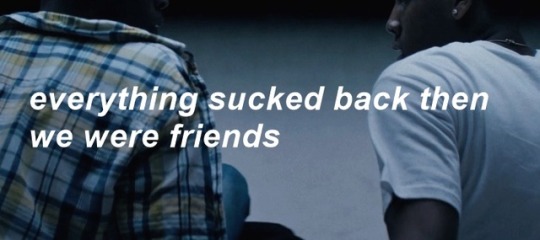
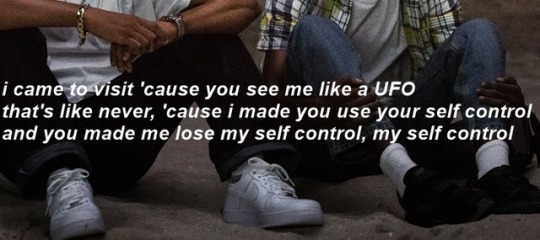

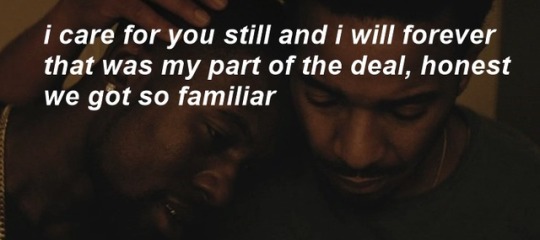


Frank Ocean’s Blonde fave lyrics
(with moonlight screencaps)
3K notes
·
View notes
Photo
Since Oscar season wasn’t too long ago, let’s throw it back to last year’s Oscar’s Best Picture Winner: Moonlight. This win was such a breakthrough for the queer black community and challenged masculinity standard for black men.



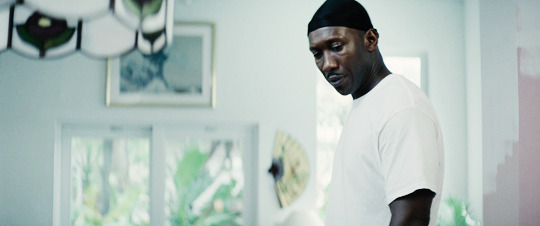





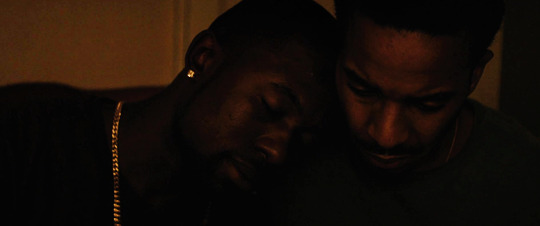
At some point, you gotta decide for yourself who you’re going to be. Can’t let nobody make that decision for you.
Moonlight (2016), dir. Barry Jenkins
8K notes
·
View notes
Video
youtube
Okay,
Just listen and learn
#Imcomingout
#wanttheworldtoknow
0 notes
Video
youtube
Considering the confusion over Gender, Genre, and Nation--I decided to upload a short clip explaining a rather fascinating tidbit of queer history.
This is a wonderful example of disobedience that stands up for the greater ideals of equality and social justice (two different things with similar goals).
This video is extremely well-done!
0 notes
Link
“These results suggest that differences in API gay men’s sexual preferences may be explained by the extent to which API gay men accept or reject prevailing notions about their racial group. A social psychological construct that explains variability across individuals’ proclivity to accept or reject prevailing negative views about their group is social dominance orientation (SDO). SDO represents individuals’ “degree of preference for inequality among social groups” (Pratto, Sidanius, Stallworth, & Malle, 1994).“
Okay, wow. There’s a lot to unpack here. Where to start:
1.) There is this prevalent orientalism that happens where gay men aren’t really seen as men--they are treated like sexulized objects, proto-women, essentially. This work seeks to understand how API men confirm or disconfirm toward API stereotypes, especially regarding the positioning of masculinity and sexual practices.
2.) This work requires a serious examination of what Asian masculinity is in the ‘Western’ world. I contend that masculinity is an affixed, white social sphere in the west that minorities are systematically excluded from.
For example, when Asian men attempt to enter the rap or hip-hop scene, because black masculinity in that context is seen as desirable. There is, of course, appropriation in order to blend in--however, blending into the toxic masculinity of whiteness is essentially impossible for non-white subjects. That’s precisely why minorities may have a SDO.
0 notes
Link
THIS! Such an important read on understanding the microaggressive tendencies White America imparts on Asian-Americans.
0 notes
Video
youtube
Madea is played by Tyler Perry, who uses this character to highlight the masculinized, ‘angry, black female’ trope that white Hollywood uses as comedic relief. Here, Perry exploits this trope as a male actor portraying a female character (though the other cast members’ characters make hints that Madea is male).
This scene is a more masculine female scene in which Madea asks like a man by deflecting Dr. Phil’s questions and refusing to be openly emotionally vulnerable.
This scene right here is pivotal to understanding a glimpse of racialized psychology. White psychology is being employed to poorly understand a complex, racialized identity that requires women of color to adopt masculine fronts as a mode of protection.
1 note
·
View note
Video
youtube
Agatha Trunchbull serves as a prime example of masculinized female subjectivity. She is overtly loud, violent, and aggressive. Her entire counterarance is predicated on fear. Her students are so afraid of her that they have referred to her as “sir.” Recall, in ‘Matilda,’ the kindest characters tend to be the female-presenting ones. Agatha Trunchbull defies the stereotype of the gentle female and is instead akin to Medea, the Greek Sorceress.
0 notes
Photo

In this image, the ‘Homosocial Triangle’ is presented. Typically, in film, literature, and other media, there tends to be homosocial conflict (rivalry) between two men and a woman, two women and one man, or rarely two same-gendered individuals vying for another same-gendered individual. These conflicts seek to provide drama, struggle, and legitimacy toward erotic, power, and sociality.
0 notes
Video
youtube
Perhaps a little too on the head, but this is perfect! Homosocial dynamics require a critical insight, especially when combatting rhetorical homophobia. Discomfort over homosexuality carries the suggestion of internal conflict, Freud would agree. Here, we can see a literal homosocial rivalry between the father and the roommate--here, the roommate’s presence and proximity to the daughter is questioned (indicating possession by the father). In order for the roommate to exist in such close quarters, there is the assumption of homosexuality and when such an assumption is denounced, the rivalry takes greater form.
0 notes
Photo

Bamby Salcedo, in a word, HERO. This woman has been through so much. She has been a survivor of gang violence, brutality, systemic racism, the racist immigration system, transphobic violence--despite all of the pain she has faced, she still persists to fight for the rights of trans* folx, especially trans* folx of color.
Bamby has touched many lives and in her documentary, she says, “you must remember your history”
If you haven’t seen TransVisible yet, I highly recommend it!
0 notes
Link
THIS book! This details the hypermasculinity found in gays; more specifically, in gay gangs--the book touches on how queer men, and especially queer men of color are forced to project certain hyper-masculine traits in order to exist. There’s this really critical examination of gay men that are forced into dating and having sex with women in order to exist in the gang, but not be outed and subsequently seen as “soft” and “weak.” Weakness means death.
Really, this book delves right into the issues of poverty, race, racial violence, and organized crime that queer folxs of color often are forced into due to being outed, thrown out of their homes, or due to a system that is engineered to exclude and starve them out.
0 notes
Text
On the Queer of Color Critique
If we could store time in a bottle,
and wish away all of ours blues,
then black and blue, and purple, and yellow--
none of them new
And we’d spend every day,
like eternity passing away--
we’d connect, just like glue
But there never seems to be enough time,
to be a person in a white world--
where dark is bad and white is good--
no wonder we are misunderstood!
If I could store color in a bottle,
the first thing that I’d like to do,
is to spend every day,
gay and free with, only answered by you
But there never seems to be enough time,
to be with the one I wanna be with,
once I find him
Because if I were queer of color,
there’s no time left for me--
I’ll spend an eternity passing away,
just waiting to be seen
0 notes
Photo

To be honest, standards for feminists haven’t changed that much since 1939 in the film industry have they? Fair skin, dainty features, submissiveness—all still very... THERE
0 notes
Video
youtube
“If it brings me to my knees, it’s a bad religion... I can never make him love me, love me, love me...” Frank Ocean made headlines and was applauded for his vulnerability with his emotions and bisexuality as a black man in the industry 🌊
0 notes
Photo

TS Madison In case you didn’t didn’t know who she was, she’s one of the most popular voices that advocates for LGBTQ rights and she’s a prominent person in the black community. One of the most important things though is that she’s the embodiment of how gender is different from sex. People think it’s interchangeable. TS Madison presents herself and identifies herself as a woman, yet she hasn’t had the sex reassignment surgery. So technically her sex is male. Gender =/= sex!
0 notes